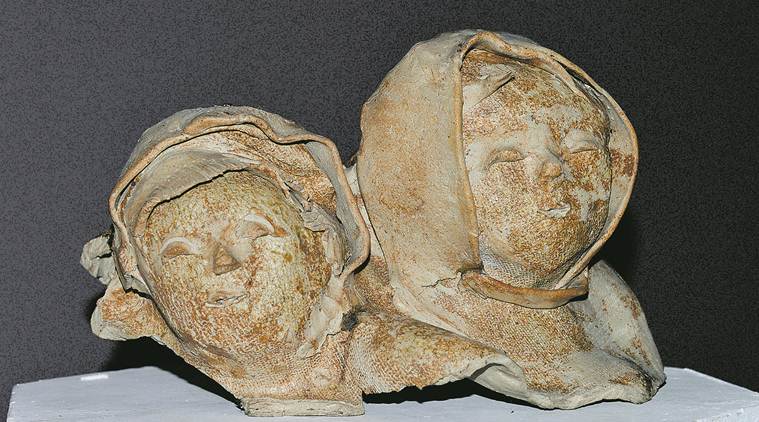Talking Heads
The display includes several familiar faces: from SK Bakre’s plaster bust of philanthropist and industrialist Sir Cowasji Jehangir to Ram Sutar’s bronze of Mahatma Gandhi, Sarbari Roy Chowdhury’s portrait of Ustad Ali Akbar Khan and Latika Katt’s bronze of Somnath Hore.
Written by Vandana Kalra |Published: November 19, 2018 1:23:24 am

The display includes several familiar faces: from SK Bakre’s plaster bust of philanthropist and industrialist Sir Cowasji Jehangir to Ram Sutar’s bronze of Mahatma Gandhi, Sarbari Roy Chowdhury’s portrait of Ustad Ali Akbar Khan and Latika Katt’s bronze of Somnath Hore.
When Adwaita Gadanayak took over as the Director General of the National Gallery of Modern Art in 2016, he was introduced to its vast collection. In the coming months, he realised that it included several works that have rarely been exhibited. “The huge collection is meant to be shared with the public,” says Gadanayak. Much time was spent studying the collection and also restoring works that had been wrapped and stored for years. A sculptor himself, Gadanayak closely monitored works belonging to the medium. Now, he intends to exhibit them in a series of exhibitions in the coming months. “Unfortunately, the medium has not received its due. Sculpting is an expensive and labourious process that requires a lot of commitment from the artist. Many youngsters are not adept at it because they find it grueling,” says he.
So the first exhibition designed to fulfill the purpose, “Chehre” befittingly has at the entrance a sculpture of Rabindranath Tagore by Ramkinkar Baij, considered one of the pioneers of modern Indian sculpture. “He was a visionary, a true master and modernist,” says Gadanayak. Talking about the showcase, he adds, “The art of modern portraiture in sculpture can be seen majorly from the colonial times, but with this exhibition a focus is drawn on the individualistic creativity of the artists rather than a particular academic style. It is interesting to study the distinctive style of each artist — for instance Ram Sutar has a lot of detailing, whereas in Baij’s work the personality of the person also comes through. We have attempted to curate the exhibition in a manner where the portraits seem to be talking to each other.”
The display includes several familiar faces: from SK Bakre’s plaster bust of philanthropist and industrialist Sir Cowasji Jehangir to Ram Sutar’s bronze of Mahatma Gandhi, Sarbari Roy Chowdhury’s portrait of Ustad Ali Akbar Khan and Latika Katt’s bronze of Somnath Hore. Baij’s bronze portrait of Abanindranath Tagore also features in the exhibition, as do several portraits of Baij himself — if in Chowdhury’s 1965 bronze his features are chiseled and ringlets of hair stand out, in Tarak Garai’s 1989 work, the master is older and visibly haggard. “In a distinctive style, Baij experimented with unconventional material such as concrete, gravel and cement, looking to the rural landscape and tribal communities for subjects,” reads a panel that summarises the practice of sculpting in India. If we are told that the 50s were “marked by experimentation with wood and stone, in which the essential character of the solid block was retained”, in the next two decades “the sculptors celebrated the spirit of humanism and their work was also infused with a sense of the spiritual that is reminiscent of classical sculptural styles”.
Incidentally, the sculpture of the month is Baij’s bronze titled Perambulator, with a mother carrying her child. He is also represented in “Roopantar”, another exhibition dedicated to rarely seen sculptures from the NGMA collection. On display is his horse head in cement. Right at the entrance of this exhibition is SK Tutu Pattanaik’s Dadi Ma Ki Kahani that invokes childhood memories, and SC Ahuja’s aluminium’s Musician. Ishwar Chandra Gouta experiments with terracotta in Putna Wadh. If Natraj Sharma’s Standing Man in fibreglass and wood stands tall and looks into the eyes of the viewer, a plaque on Pushp Betala’s 1983 metal work — with portraits of three men — reveals the work was priced Rs 4,000 in 1983, indicative of the art market back then.
Gadanayak shares how more exhibitions will be curated to showcase sculptures from the NGMA collection. He also plans to commission new work. “I want to promote public works. I also want to commission young artists, conduct workshops with them, invest in the future,” says Gadanayak. The larger aim is to make art less intimidating for the masses. “Cafe Lota is going to open in the premises in a few months. More interactive sessions on art and workshops are also being planned. We want to help people understand and learn about Indian art. They should feel proud of our art that has also received global recognition,” says Gadanayak.






















No hay comentarios:
Publicar un comentario